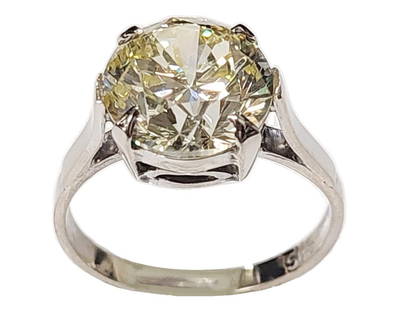
11th C. Persian Gold Ring Garnet Intaglio w/ Peacock
Similar Sale History
View More Items in Signet RingsRelated Signet Rings
More Items in Signet Rings
View MoreRecommended Rings
View More




Item Details
Description
**Originally Listed At $2750**
Near East, Persia (Iran), Seljuq (Saljuq/Seljuk) Empire, ca. 12th to 13th century CE. An elegant cabochon garnet intaglio of a peacock, set into a high-quality gold ring setting and band further embellished with cast avian motifs – cast from an 85.86% to 97.77% gold (equivalent to 20K+ to 23K+)! The high oval bezel houses a deep wine-red cabochon garnet, held in place by 4 prongs; the stone etched with a peacock made by simple linear markings. The sides of bezel lip contain low relief motifs of scrolling foliage and stippling. The broad shoulders of the shank displays pairs of birds facing left and right in profile, the band then tapers to a hollow oval on the underside, that once contained a small gem - suggesting this was a thumb ring. This is a stunning piece that may have been a signet ring or seal for an important member of society! Size of bezel face: 0.56" L (1.4 cm); band opening: 0.7" L (1.8 cm); US ring size: 7; gold quality: 85.86% to 97.77% (equivalent to 20K+ to 23K+); weight: 8.2 grams
Peacocks are powerful symbols of aristocracy - in Persian cultures they were associated with the sun, beauty, glory, immortality, and wisdom. The name garnet comes from the Latin word "granatus," meaning "seed-like" - a likely allusion to the similarities in appearance of small red garnets and pomegranate seeds that also had connotations of fertility and prosperity in the Near East. Garnets were popular gemstones, considered just as beautiful as rubies. The very earliest descriptions of garnet date to Roman times; Pliny the Elder (23/24 to 79 CE) referred to the dark-red variety as carbunculus alabandicus, the fire-stone from the city of Alabanda (modern Turkey), an important market place for gemstones found in Asia during Pliny's time.
PLEASE NOTE: Due to recent increases of shipments being seized by Australian & German customs (even for items with pre-UNESCO provenance), we will no longer ship most antiquities and ancient Chinese art to Australia & Germany. For categories of items that are acceptable to ship to Australia or Germany, please contact us directly or work with your local customs brokerage firm.
Provenance: private Boynton Beach, Florida, USA collection; ex-private Dr. Yahya Jafar collection, Muscat, Oman, assembled between the early 1960s and late 1990s
All items legal to buy/sell under U.S. Statute covering cultural patrimony Code 2600, CHAPTER 14, and are guaranteed to be as described or your money back.
A Certificate of Authenticity will accompany all winning bids.
We ship worldwide to most countries and handle all shipping in-house for your convenience.
#174614
Near East, Persia (Iran), Seljuq (Saljuq/Seljuk) Empire, ca. 12th to 13th century CE. An elegant cabochon garnet intaglio of a peacock, set into a high-quality gold ring setting and band further embellished with cast avian motifs – cast from an 85.86% to 97.77% gold (equivalent to 20K+ to 23K+)! The high oval bezel houses a deep wine-red cabochon garnet, held in place by 4 prongs; the stone etched with a peacock made by simple linear markings. The sides of bezel lip contain low relief motifs of scrolling foliage and stippling. The broad shoulders of the shank displays pairs of birds facing left and right in profile, the band then tapers to a hollow oval on the underside, that once contained a small gem - suggesting this was a thumb ring. This is a stunning piece that may have been a signet ring or seal for an important member of society! Size of bezel face: 0.56" L (1.4 cm); band opening: 0.7" L (1.8 cm); US ring size: 7; gold quality: 85.86% to 97.77% (equivalent to 20K+ to 23K+); weight: 8.2 grams
Peacocks are powerful symbols of aristocracy - in Persian cultures they were associated with the sun, beauty, glory, immortality, and wisdom. The name garnet comes from the Latin word "granatus," meaning "seed-like" - a likely allusion to the similarities in appearance of small red garnets and pomegranate seeds that also had connotations of fertility and prosperity in the Near East. Garnets were popular gemstones, considered just as beautiful as rubies. The very earliest descriptions of garnet date to Roman times; Pliny the Elder (23/24 to 79 CE) referred to the dark-red variety as carbunculus alabandicus, the fire-stone from the city of Alabanda (modern Turkey), an important market place for gemstones found in Asia during Pliny's time.
PLEASE NOTE: Due to recent increases of shipments being seized by Australian & German customs (even for items with pre-UNESCO provenance), we will no longer ship most antiquities and ancient Chinese art to Australia & Germany. For categories of items that are acceptable to ship to Australia or Germany, please contact us directly or work with your local customs brokerage firm.
Provenance: private Boynton Beach, Florida, USA collection; ex-private Dr. Yahya Jafar collection, Muscat, Oman, assembled between the early 1960s and late 1990s
All items legal to buy/sell under U.S. Statute covering cultural patrimony Code 2600, CHAPTER 14, and are guaranteed to be as described or your money back.
A Certificate of Authenticity will accompany all winning bids.
We ship worldwide to most countries and handle all shipping in-house for your convenience.
#174614
Condition
Missing gemstone on small bezel on underside of band. Surface abrasions to gold band, some bending to band. Softening to raised gold motifs on bezel lip. Garnet is slightly loose in bezel but secure via the prongs. Garnet is intact and peacock motif is well preserved and excellent. Ring is wearable!
Buyer's Premium
- 26.5%
11th C. Persian Gold Ring Garnet Intaglio w/ Peacock
Estimate $4,000 - $8,000
13 bidders are watching this item.
Shipping & Pickup Options
Item located in Louisville, CO, usSee Policy for Shipping
Payment
Accepts seamless payments through LiveAuctioneers

TOP



































































